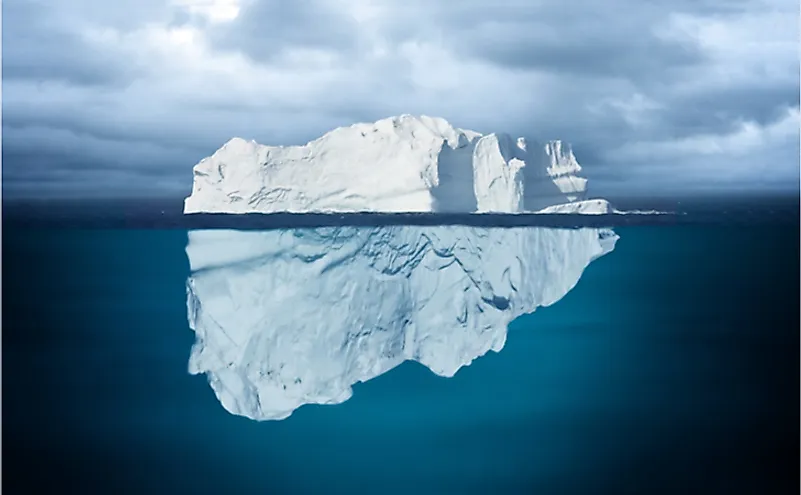The 10 Largest Icebergs Ever

An iceberg is any large piece of ice that has broken off a dense body of ice, such as a glacier or ice shelf. After breaking off, icebergs, which are made of freshwater, float in the saltwater of an ocean or sea. They are common in the Arctic, Atlantic, and Pacific Oceans. Icebergs are considered a maritime hazard because most of the ice mass of the iceberg is hidden below the surface, and therefore only a small portion is visible above. Consequently, icebergs can cause accidents at sea.
The 10 Largest Icebergs Ever
1. Iceberg B-15
The largest iceberg ever recorded was Iceberg B-15, which was recorded in the year 2000 after breaking off the Ross Ice Shelf in Antarctica. It measured approximately 295 km long, 37 km wide, and had a surface area of 11,007 km2. Iceberg B-15 eventually disintegrated into smaller pieces and drifted across the Antarctic Ocean. The last small piece of the iceberg was observed in 2011.
2. Iceberg A-38
The second-largest iceberg ever recorded was A-38, which was observed in 1998 after breaking off the Filchner-Ronne Ice Shelf in Antarctica. The iceberg measured approximately 144 km long, 48 km wide, and had a surface area of 6,900 km2. The iceberg later broke into two large fragments and many smaller bergs.
3. Iceberg B-15A
Iceberg B-15A was the third-largest iceberg ever recorded, after breaking off Iceberg B-15. It was recorded in the year 2002 and had an area of 6,400 km2. The iceberg later collided with the Drygalski Ice Tongue, which caused it to break apart. However, it was not until 2006 that the final pieces of Iceberg B-15A drifted away into the open sea.
4. Iceberg A-68
Iceberg A-68, which broke off the Larsen C Ice Shelf, ranks as the fourth largest iceberg ever recorded. It formed in 2017 and covered a surface area of approximately 5,800 km2.
5. Iceberg C-19
The fifth-largest iceberg ever recorded, Iceberg C-19, was formed in 2002 after breaking away from the Ross Ice Shelf. The iceberg had a surface area of approximately 5,500 km2.
6. Iceberg B-9
Iceberg B-9 broke off the eastern part of the Ross Ice Shelf in 1987. It had a surface area of approximately 5,390 km2, ranking as the sixth-largest iceberg ever recorded.
7. Iceberg B-31
Iceberg B-31 was the seventh-largest iceberg ever recorded, with a surface area of 660 km2. The iceberg measured 33 km long, 20 km wide, and had a thickness of 500 km. Iceberg B-31 was formed in 2013 after breaking off the Pine Island Glacier.
8. Iceberg D-16
The eighth-largest iceberg ever recorded was Iceberg D-16, which had a surface area of approximately 310 km2. The iceberg was formed in 2006 after breaking off the Fimbul Ice Shelf.
9. Iceberg Petermann Ice Island (2010)
The Petermann Ice Island ranks as the ninth-largest iceberg ever recorded, with a surface area of approximately 260 km2. The iceberg was discovered in 2010 after breaking off the Petermann Glacier in Greenland.
10. Iceberg B-44
Iceberg B-44 was the tenth largest iceberg ever recorded, with a surface area of approximately 256 km2. Like Iceberg B-31, Iceberg B-44 also broke off the Pine Island Glacier.
List of the 10 Largest Icebergs Ever Recorded
| Rank | Iceberg | Maximum Surface Area (km²) | Year Recorded |
|---|---|---|---|
| 1 | B-15 | 11,007 | 2000 |
| 2 | A-38 | 6,900 | 1998 |
| 3 | B-15A | 6,400 | 2002 |
| 4 | A-68 | 5,800 | 2017 |
| 5 | C-19 | 5,500 | 2002 |
| 6 | B-9 | 5,390 | 1987 |
| 7 | B-31 | 660 | 2013 |
| 8 | D-16 | 310 | 2006 |
| 9 | Petermann Ice Island (2010) | 260 | 2010 |
| 10 | B-44 | 256 | 2017 |











